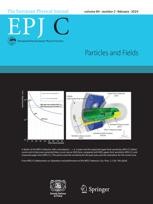Celebrating 50 years of QCD with a comprehensive review
A series of key experiments performed about 50 years ago revealed the eminent role of gauge theories. Two theories were formulated: the electroweak theory and the strong interaction theory QCD. An extensive worldwide research programme has since been set up and has step by step corroborated their predictions, while alternative theoretical attempts have been ruled out. Today these theories are well established and represent the cornerstones of the Standard Model.
New York | Heidelberg, 15 December 2023
 The main authors, Franz Groß and Eberhard Klempt, succeeded in gathering experts to write articles covering all aspects of the vast field of strong interaction processes, described by Quantum Chromodynamics QCD, the theory of strong interactions. The fruit of their labours is a comprehensive review, ca. 650 pages long, published in the European Physical Journal C (EPJ C). The major aspects are outlined in 14 chapters, each of which is devoted to a specific topic. The authors’ goal was to provide general and detailed insights into both experiment and theory, for the benefit of research students and other interested readers alike.
The main authors, Franz Groß and Eberhard Klempt, succeeded in gathering experts to write articles covering all aspects of the vast field of strong interaction processes, described by Quantum Chromodynamics QCD, the theory of strong interactions. The fruit of their labours is a comprehensive review, ca. 650 pages long, published in the European Physical Journal C (EPJ C). The major aspects are outlined in 14 chapters, each of which is devoted to a specific topic. The authors’ goal was to provide general and detailed insights into both experiment and theory, for the benefit of research students and other interested readers alike.
The field has evolved over the past five decades and the respective chapters reflect its historical development and increasing complexity. The corresponding experiments, which were initially performed on the energy scale of order GeV, have since reached the TeV scale – advances driven by intensive interaction between experiment, theory and accelerator. The exploration of this vast energy range was achieved in fixed target experiments with electron, muon and neutrino beams, followed by electron and proton collider experiments with ever-increasing energy : PETRA, PEP, LEP, HERA and SppS, Tevatron, and the LHC. The chapters provide insight into the evolution of detector techniques, the development of analysis and computing tools until the creation of the world wide web. They address as well the simultaneous development of the theory, both at the fundamental and the phenomenological level.
The first two chapters outline the theoretical and experimental foundations of the field of strong interactions. The discovery of the nucleon’s substructure opened a new and rich avenue of research. With increasing energy and resolution power, in addition to the three light quarks, new species of heavy mass appeared: first the charmed quark (c) (Chapter 2.1), then the bottom quark (b) and finally the very heavy top (t) quark (both in Chapter 12.5). Chapters 8 and 9 address the spectroscopy of mesons and baryons with light and heavy flavours, while Chapter 10 focuses on the structure of the nucleon, in particular the parton distribution functions – which include not only the quarks in all their flavours, but also the gluon. Jets represent an important tool for investigating strong interactions. They were uniquely established as soon as the e+e- colliders PETRA, PEP and Spp ̅S became available. Chapter 12 provides detailed insights into them. Fundamental quantities of QCD are discussed in Chapter 3. Chapter 12 presents recent investigations at high-energy colliders. QCD is very simple at the microscopic level, but manifests high complexity at larger scales of resolution. This calls for special approaches and methods, as outlined in Chapters 4, 5 and 6. The behaviour of nuclear matter under extreme conditions, including the formation of a quark-gluon plasma, is presented in Chapter 7. The role of QCD effects in meson and baryon decays is discussed in Chapter 13. Lastly, Chapter 14 gives an outlook on future facilities.
In conclusion, the review offers comprehensive and balanced insights into the broad field of strong interactions from its roots to the present, and is recommended as valuable source of knowledge and inspiration.
Reference: Gross, F., Klempt, E., Brodsky, S.J. et al. 50 Years of quantum chromodynamics. Eur. Phys. J. C 83, 1125 (2023). https://doi.org/10.1140/epjc/s10052-023-11949-2
Further Information
For more information visit: www.epj.org
Services for Journalists
The full-text article is available open access here.
Contact
Sabine Lehr | Springer | Physics Editorial Department
tel +49-6221-487-8336 | sabine.lehr@springer.com
